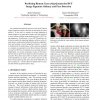Free Online Productivity Tools
i2Speak
i2Symbol
i2OCR
iTex2Img
iWeb2Print
iWeb2Shot
i2Type
iPdf2Split
iPdf2Merge
i2Bopomofo
i2Arabic
i2Style
i2Image
i2PDF
iLatex2Rtf
Sci2ools
148
click to vote
WACV
2012
IEEE
2012
IEEE
Predicting human gaze using quaternion DCT image signature saliency and face detection
We combine and extend the previous work on DCT-based image signatures and face detection to determine the visual saliency. To this end, we transfer the scalar definition of image signatures to quaternion images and thus introduce a novel saliency method using quaternion type-II DCT image signatures. Furthermore, we use MCT-based face detection to model the important influence of faces on the visual saliency using rotated elliptical Gaussian weight functions and evaluate several integration schemes. In order to demonstrate the performance of the proposed methods, we evaluate our approach on the Bruce-Tsotsos (Toronto) [2] and Cerf (FIFA) [3] benchmark eye-tracking data sets. Additionally, we present evaluation results on the BruceTsotsos data set of the most important spectral saliency approaches. We achieve state-of-the-art results in terms of the well-established area under curve (AUC) measure on the Bruce-Tsotsos data set and come close to the ideal AUC on the Cerf data set – wi...
| Added | 25 Apr 2012 |
| Updated | 25 Apr 2012 |
| Type | Journal |
| Year | 2012 |
| Where | WACV |
| Authors | Boris Schauerte, Rainer Stiefelhagen |
Comments (0)

